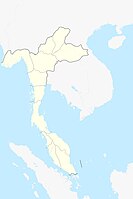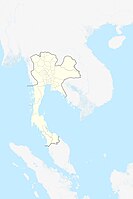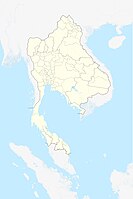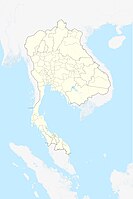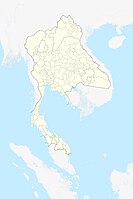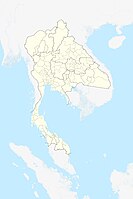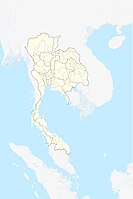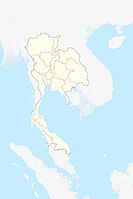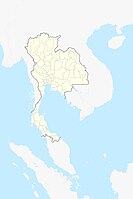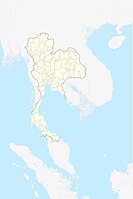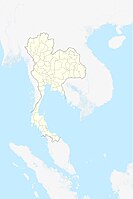Administrative divisions of Thailand
| Administrative divisions of Thailand | ||||||||
|---|---|---|---|---|---|---|---|---|
| Provincial divisions | ||||||||
|
||||||||
| Local divisions | ||||||||
|
||||||||
| Note: † Special administrative area | ||||||||
Thailand is a unitary state, which means the territories are separated into central co-dependencies, with the central government deciding everything for the provinces.[1] The kingdom is separated into multiple levels including regions, provinces, and many more. Though, formally, Thailand is separated into three levels: provinces, districts, and sub-districts, there are also informal divisions such as parimonthon, and phak.[2] Furthermore, there are administrative divisions of the same level with different names such as the first-level divisions of the province and the special administrative region.
The governance is separated into two branches, regular and municipal administration.[3] The regular administration is governed by the central government directly, with the municipal administration being given more autonomy by the central government, though still heavily restricted due to the over centralization of the Thai administrative system. This system arose during Rama V's reign where the governing system of the Kingdom of Siam was changing rapidly due to westernization.[4]
Provincial administrative divisions
Provinces

Changwat (Thai: จังหวัด) or provinces is the first level of administration, the highest level, of Thailand. Thailand is separated into 76 provinces, though commonly mistaken as 77 provinces due to Bangkok's former status as a province itself. This is the highest level of administrative division within the kingdom. Each of the provinces are led by governor. The changwat is responsible for implementing state policy and enforcing laws.[5]
Governance
The provinces are governed by a governor appointed by the central government. Specifically, the Ministry of the Interior is a part of the Bangkok Government. [citation needed] The norm for naming the provinces is using the provincial capital as the name, which is why they are called namesake cities. A notable difference from history was during the post-Franco-Siamese crisis period when there was a DMZ around the border which falls on the Mekong river. During this time, there was a province called Nong Khai but the capital was in Ban Makkhaeng.[citation needed] A province is administered by a governor (ผู้ว่าราชการจังหวัด) who is appointed by the Minister of Interior. The provinces are named after their namesake cities, a cities which were the "capital" at the time of its founding. Also, in several provinces the administration has been moved into a new building outside the city.[citation needed]
History
Ayutthaya Kingdom
Most provinces date back to the time of subservient city-states, chiefdoms, and even vassal kingdoms. The polity was called muangs, not to be confused with modern muangs which means cities, which had their own satellite muangs.[6] Traditionally ruled by a local ruling family, these muangs had a high level of autonomy. The highest king of these muangs, phaya or khun luang,[7] though the titles changes over history, ruled these muangs through a system of tributes. The king did not have much control over these muangs which lead to uprisings and rebellions. During the war, these muangs often switched sides which leads to the downfall of the Ayutthaya Kingdom.
The provinces were separated into two classes and four different levels.[8]
| Levels | First | Second | Third | Forth |
|---|---|---|---|---|
| Central | Wiang (เวียง) | Wang (วัง) | Khlang (คลัง) | Na (นา) |
| Vassal | Muang Luk Luang (เมืองลูกหลวง) | Inner Hua Muang (หัวเมืองชั้นใน) | Outer Hua Muang (หัวเมืองชั้นนอก) | Muang Prathetsarat (เมืองประเทศราช) |
Rattanakosin Kingdom

During this era, nothing changed much at the beginning. But when the western colonial powers started to eye the region, The Siamese government took to reform their administrative division into a form that much resembles the modern structure. In 1882, much of the current political geography of Siam had changed drastically. Rama V, who had been ramping up the reformation of Siam, had devised a plan to divide Siam into several levels of administration. During this era, the province wasn't the highest level of division. This falls to the monthon and the vassal kingdoms.[citation needed] At the time, Siam was a minor power, controlling several minor kingdoms on their frontiers with the major colonial powers. By, 1892, much of the divisions had already been formed, though this is far from modern Thailand's divisional structure, and by 1900 most of the territory gained during the rule of Rama III were lost to France and Britain.[9]
In 1908, a new division called boriwen was introduced, though later abolished due to its overlapping duties with other local governments, and the bureaucratic costs to maintain the divisions.[10]
In 1932, there were major reforms all over the kingdom, monthon was abolished, provinces merged, and several other divisions dissolved into higher divisions to cut costs. The former provinces that were lost are merged into other provinces or ceded to western powers.
During the 20th century, a massive reform occurred gradually over the century, which saw the formation of several provinces through partitions. The newest province is Bueng Kan which split from Nong Khai on 23 March 2011.[11]
Current and Former Capital of Thailand
| Singhanavati Kingdom | ||||||||
|---|---|---|---|---|---|---|---|---|
| Yonok Nahaphan
(BC) 691-545 (AD) Capital Destroyed | ||||||||
| Vieng Preuksa
545-638 Kingdom Reestablished, Capital Moved | ||||||||
| Lavo Kingdom | Hiran-Ngoenyang Kingdom | |||||||
| Lavo (Lopburi)
468-1082 |
Hiran
638 - 850 | |||||||
| Suphannaphum Confederation | Ngoenyang
850-1262 |
Phayao Kingdom | ||||||
| Ayutthaya
1082-1351 Ayutthaya Ceceeded |
Suphanburi
1000s-1351 Joined Ayutthaya |
Chiang Rai
1262-1275 |
Phayao
1094–1338 Lanna Annexed | |||||
| Fang
1275–1281 | ||||||||
| Wiang Kum Kam
1281–1292 Kingdom Reestablished | ||||||||
| Sukhothai Kingdom | Lavo (Lopburi)
1351-1388 Joined Ayutthaya |
Nakhon Si Thammarat Kingdom | Lanna Kingdom | |||||
| Sukhothai
1238-1347 |
Ayutthaya Kingdom | Nakhon Si Thammarat
1200s-1782 Rattanakosin Annexed |
Chiang Mai
1292–1775 Direct Governance then Kingdom Partitioned into Rattanatingsa, Nan, Lampang, Lamphun, Phrae, Thoen | |||||
| Songkhwae (Phitsanulok)
1347–1438 Ayutthaya Annexed |
Ayutthaya
1351–1463 |
|||||||
| Phitsanulok
1463-1488 | ||||||||
| Ayutthaya
1488-1680 |
Phitsanulok
1488-1590 (co-capital) | |||||||
| Lopburi
1680-1688 | ||||||||
| Ayutthaya
1688-1767 Kingdom Partitioned into Phimai, Thonburi, Phitsanulok, Sawangkhaburi | ||||||||
| Phimai Kingdom | Thonburi Kingdom | Phitsanulok Kingdom | Sawangkhaburi | |||||
| Phimai
1767 Thonburi Annexed |
Thonburi
1767–1782 Coup & Refounded |
Phitsanulok
1767 Thonburi Annexed |
Sawangkhaburi
1767 Thonburi Annexed | |||||
| Rattanakosin Kingdom | Rattanatingsa | Nan
Kingdom |
Lampang
Principality |
Lamphun
Principality |
Phrae
Principality | |||
| Pra Nakhon (Bangkok)
1782–1932 Kingdom Restructured |
Chiang Mai
1802–1899 |
Nan
1802–1899 |
Lampang
1802–1899 |
Lamphun
1802–1899 |
Phrae
1802–1899 | |||
| Rattanakosin Annexed | ||||||||
| Thailand | ||||||||
| Bangkok
1932-Now | ||||||||
Former Provinces of Thailand
The former of provinces are administrative divisions which were either ceded, partitioned, or merged with the neighbouring territories. Over the course of history, the definition of provinces may change, thus the provinces listed under here are definitive provinces, or provinces which are created according to decrees. Furthermore, the list also includes provinces which were created during the mandala system era. These mandala provinces are defined as cities which controlled the surrounding cities, which in itself has subservient townships and villages. Examples of definite province include the province of Minburi,[12] which was created through a decree passed by Rama V. Examples of mandala provinces include the province of Nakhon Ratchasima. Though Nakhon Ratchasima may be classified as a definite province these days, back in the days of King Rama I, Nakhon Ratchasima was the very definition of a mandala province. For example, the city of Nakhon Ratchasima oversaw the city of Si Phum, which inturn oversaw the city of Kalasin, which inturn oversaw the neighbouring townships and villages' affairs.[13] What is not listed here are muang prathetsarat. These polities are not provinces by any definition, but are vassal states. Though, some may be in the grey area, by which treads the line between full provincialship and vassalage. For example, the Principality of Thoen.[13][14][15][16][17][18][19]

Core Provinces
| Provinces
(Thai Name) |
Original Names
or Native Names |
Made Province / Founded in | Ceased to be Province in | Fate | Today Part of |
|---|---|---|---|---|---|
| Bang Lamung
บางละมุง |
บ้านนาเกลือ
Ban Na Kleua |
1782 | 1910s | merged with Bang Pla Soi | Chonburi |
| Bang Pla Soi | บางปลาสร้อย | 1376 | 1910s | merged with Bang Lamung and Phanat Nikhom to form Chonburi | Chonburi |
| Chaibadan | ชัยบาดาล | 700s | 1902 | merged into Wichianburi | Phetchabun |
| Chiaya
ไชยา |
ครหิ
Khri |
1820s | 1890s | merged into Kanchanadit | Surat Thani |
| Inburi | อินทร์บุรี | 1369 | 1897 | merged into Singburi | Singburi |
| Kabinburi
กะบิ่นบุรี (กระบินทร์บุรี) |
ด่านหนุมาน
Dan Nu Man |
1901 | 1926 | merged with Prachinburi | Prachinburi and Sa Kaeo |
| Khirirat Nikhom
คีรีรัฐนิคม |
ท่าขนอน
Tha Khanon |
1820s | 1890s | merged into Kanchanadit | Surat Thani |
| Kraburi
กระบุรี |
ตระ
Tra |
1870s | 1896 | merged into Ranong | Ranong |
| Lang Suan
หลังสวน |
คลังสวน
Klang Suan |
1870s | 1932 | merged into Chumphon | Chumphon |
| Lom Sak
หล่มสัก |
วัดป่า
Wat Pa |
1767 | 1916 | partitioned between Phetchabun and Loei | Phetchabun and Loei |
| Manorom | มโนรมย์ | before 1770s | 1897 | merged into Chai Nat | Chai Nat |
| Min Buri
มีนบุรี |
ท้องนากว้างใหญ่
Thongna Kwangyai |
1901 | 1931 | merged into Phra Nakhon | Bangkok |
| Nakhon Chai Si | นครชัยศรี | 1570s | 1910s | capital moved to Nakhon Pathom | Nakhon Pathom |
| Nakhon Khuan Khan | นครเขื่อนขันธ์ | 1819 | 1915 | renamed Phra Pradaeng | Bangkok and Samut Prakan |
| Phanat Nikhom
พนัสนิคม |
พระรถ
Phra Rot |
before 1770s | 1910s | merged with Bang Pla Soi | Chonburi |
| Phanom Sarakham
พนมสารคาม |
ดงยาง
Dong Yang |
before 1770s | 1910s | merged into Chachoengsao | Chachoengsao |
| Phayu Ha Khiri
พยุหะคีรี |
บ้านพยุแดน
Ban Phayu Daen |
before 1770s | 1890s | merged into Nakhon Sawan | Nakhon Sawan |
| Phichai | พิชัย | 1500s | 1887 | capital moved to Uttaradit | Uttaradit, Phitsanulok, and Loei |
| Phra Nakhon
พระนคร |
ชนะสงคราม
Chana Songkhram |
1782 | 1972 | merged with Thonburi to form Bangkok | Bangkok |
| บางกอก
Bang Kok | |||||
| Phromburi
พรหมบุรี |
พรหมนคร
Phrom Nakhon |
1350s | 1890s | merged into Singburi | Singburi |
| Pra Pradaeng
พระประแดง |
นครเขื่อนขันธ์
Nakhon Kheuan Khan |
1915 | 1932 | merged with Samut Prakan, partitioned from Pra Nakhon and Samut Prakan, merged between Samut Prakan and Thonburi | Samut Prakan and Bangkok |
| Sangkhaburi
สรรคบุรี |
แพรกศรีราชา
Phraek Siracha |
1300s | 1897 | merged into Chai Nat | Chai Nat |
| ไตรตรึงส์
Trai Treung | |||||
| Sawankhalok | สวรรคโลก | 1894 | 1939 | merge with Sukhothai to form Sawankhalok, later changing the name to Sukhothai | Sukhothai |
| Si Thep
ศรีเทพ |
อภัยสาลี
Aphai Sali |
before 1770s | 1820s | capital moved to Wichianburi | Phetchabun |
| Takua Pa
ตะกั่วป่า |
ตะโกลา
Taloka |
1870s | 1932 | merged into Pang Nga | Pang Nga |
| Takua Thung
ตะกั่วทุ่ง |
กราภูงา
Kra Phunga |
1820s | 1899 | merged into Pang Nga | Pang Nga |
| Thalang | ถลาง | 1820s | 1812 | destroyed during the Burmese–Siamese War (1809–1812), which then the territory is administered by Nakhon Si Thammarat | Phuket |
| Thanyaburi
ธัญบุรี |
รังสิต
Rangsit |
1901 | 1932 | merged into Pathum Thani | Pathum Thani |
| Thonburi Si Mahasamut
ธนบุรีศรีมหาสมุทร |
บางกอก
Bang Kok |
1767 | 1972 | merged with Phra Nakhon to form Bangkok | Bangkok |
| Wichianburi
วิเชียรบุรี |
ท่าโรง
Tha Rong |
1830s | 1898 | merged into Phetchabun | Phetchabun |
Lanna Frontier
| Provinces
(Thai Name) |
Native Names
(Local/Original Names) |
Made Province in | Ceased to be Province in | Fate | Today Part of |
|---|---|---|---|---|---|
| Chiang Khaeng
เชียงแขง |
ဝဵင်းၵဵင်းၸဵင်
Weng Keng Cheng |
1892 | 1893 | partitioned between France and Britain, as part of the Franco-Siamese War in 1893 | Shan State |
| Saharat Thai Doem | สหรัฐไทยเดิม | 1943 | 1945 | ceded to Britain | Shan State |
| Uthai
อุทัย Lan Chang ล้านช้าง |
ປາກລາຍ
Paklay |
1940 | 1945 | ceded to France | Sainyabuli and Luang Prabang |
Lan Chang Frontier
| Provinces
(Thai Name) |
Native Names
(Local/Original Names) |
Made Province in | Ceased to be Province in | Fate | Today Part of |
|---|---|---|---|---|---|
| Attapue
อัตตะปือ |
ອັດກະປື
Atkapu |
1778 | 1893 | ceded to France, as part of the Franco-Siamese War in 1893 | Attapeu |
| Borikhan Nikhom
บริคัณฑ์นิคม |
ປະຊຸມພະນາລັຍ
Paxoumphanalai |
1830 | 1893 | ceded to France, as part of the Franco-Siamese War in 1893 | Bolikhamxai |
| Chaiburi
ไชยบุรี |
ປາກນ້ຳສົງຄາມ
Paknam Songkham |
1830 | 1914 | merged with Nong Khai | Bueng Kan |
| Chiang Khouang
เชียงขวาง |
ພວນ
Phouan |
1828 | 1893 | ceded to France, as part of the Franco-Siamese War in 1893 | Xiangkhouang |
| Chonnabot
ชนบท |
ຫນອງແກ້ວ Nongkeo
(ບຶງແກ້ວ) (Bungkeo) |
1792 | 1914 | partitioned between Chaiyaphum and Khon Kaen | Chaiyaphum and Khon Kaen |
| Det Udom
เดชอุดม |
ປາກໂດມ Pakdom
(ໂດມໃຫຍ່) (Domnyai) |
1845 | 1912 | merged into Sisaket | Ubon Ratchathani |
| Kamalasai
กมลาสัย |
ສະປົວດົງມະຂາມເກົ່າ
Sapouadongmakhamkao |
1840 | 1913 | partitioned between Kalasin and Roi Et | Kalasin and Roi Et |
| Kham Kert
คำเกิด |
ຄຳເກີດ
Khamkeut |
1839 | 1893 | ceded to France, as part of the Franco-Siamese War in 1893 | Khammouane |
| Kham Muan
คำม่วน |
ຄຳມ່ວນ
Khammouan |
1839 | 1893 | ceded to France, as part of the Franco-Siamese War in 1893 | Khammouane |
| Kham Thong Luang
คำทองหลวง |
ແກ້ງອາເຣີມ
Kengareum |
1828 | 1893 | ceded to France, as part of the Franco-Siamese War in 1893 | Stung Teng |
| Khemmarat
เขมราฐ (เขมราฐธานี) |
ໂຄກກົ່ງດົງພະນຽງ
Khokkongdongphaniang |
1814 | 1893 | partitioned between Siam and France, merged into Ubon Ratchathani, as part of the Franco-Siamese War in 1893 | Ubon Ratchathani and Yasothon |
| Khon San
คอนสาร |
ຄອນສານ
Khonsan |
1787 | 1890s | partitioned between Chaiyaphum and Khon Kaen | Chaiyaphum and Khon Kaen |
| Khukhan
ขุขันธ์ (คุขันธ์) |
ປາສາດສີ່ຫຼ່ຽມ
Pasat Siliam |
1759 | 1938 | partitioned between Siam and France, merged with Sisaket and Det Udom District, but later the province moved the capital to Sisaket, as part of the Franco-Siamese War in 1893 | Ubon Ratchathani and Sisaket |
| Phra Tabong
พระตะบอง |
បាត់ដំបង
Badthumbang |
1795 | 1893 | ceded to France, as part of the Franco-Siamese War in 1893 | Banteay Meanchey, Siem Reap, Pailin, and Battambang |
| Nang Rong
นางรอง |
ນະຮອງ
Nahong |
1820s | 1892 | merged into Buriram | Buriram |
| Nong
นอง |
ນອງ
Nong |
1825 | 1890s | merged with Mukdahan | Savannakhet |
| Nong Han
หนองหาร (หนองละหาร) |
ຫນອງຫານນ້ອຍ
Nonghannoy |
1787 | 1910s | merged with Nong Khai | Nong Khai |
| Phon Phisai
โพนพิสัย |
ໂພນແພງ
Phonpheng |
1830 | 1906 | merged with Nong Khai | Nong Khai and Bueng Kan |
| Phu Khiao | ภูเขียว | 1810s | 1899 | merged into Chaiyaphum | Chaiyaphum |
| Phu Len Chang
ภูแล่นช้าง |
ພູແດນຊ້າງ
Phoudenxang |
1840 | 1910s | merged into Kalasin | Kalasin |
| Phutthaisong
พุทไธสง |
ຫມາກເຟືອງຫົວແຮດ
Makfuang Houahet |
1820s | 1892 | merged into Buriram | Buriram |
| Pra Khon Chai
ประโคนชัย (ตะลุง) |
ຕະລຸມດອ
Taloumdo ตลุง Talung |
1820s | 1892 | merged into Buriram | Buriram |
| Rattanaburi
รัตนบุรี |
เมืองศรีนครเตา
Muang Si Nakhon Tao |
1820s | 1892 | merged into Buriram | Surin |
| Salawan
สาละวัน |
ເມືອງມັ່ນ
Muangman |
1828 | 1893 | ceded to France, as part of the Franco-Siamese War in 1893 | Salavan and Sekong |
| Sangkha
สังขะ (สังฆะ) |
ໂຄກອັຈຈະ
Khokachcha |
1759 | 1893 | partitioned between Siam and France, merged into Surin, as part of the Franco-Siamese War in 1893 | Surin |
| Suwannaphum
สุวรรณภูมิ |
ສີພູມ
Siphum |
1772 | 1908 | partitioned between Maha Sarakham and Roi Et | Maha Sarakham and Roi Et |
| Tha Uthen
ท่าอุเทน |
ທ່າບຶງອຸ
Thabungou |
1830 | 1907 | merged with Nakhon Phanom | Nakhon Phanom |
| Wang
วัง |
ວັງ
Vang |
1830 | 1890s | merged with Mukdahan | Savannakhet |
Khmer Frontier
| Provinces
(Thai Name) |
Native Names
(Local/Original Names) |
Made Province in | Ceased to be Province in | Fate | Today Part of |
|---|---|---|---|---|---|
| Chiang Taeng
เชียงแตง |
ស្ទឹងត្រែង
Stoengtrang |
1784 | 1893 | ceded to France, as part of the Franco-Siamese War in 1893 | Kratié, Stung Treng, Ratanakiri, and Mondulkiri |
| Khlung | ขลุง | 1820s | 1898 | partitioned between Chanthaburi and Trat, as part of the Franco-Siamese War in 1893, when the province of Chanthaburi came under French occupation, in which a 10 km DMZ was declared on the Thai side of the Mekong river. | Chanthaburi and Trat |
| Phanom Sok
พนมสก |
ភ្នំស្រុក
Phnomsrok |
1835 | 1893 | ceded to France, as part of the Franco-Siamese War in 1893 | Banteay Meanchey, Siem Reap, and Oddar Meanchey |
| Phibunsongkhram | พิบูลสงคราม | 1941 | 1946 | concession to France, allowing the Kingdom of Thailand to join the United Nation, passing the French veto. | Banteay Meanchey, Siem Reap, Oddar Meanchey, and Preah Vihear |
| Nakhon Champassak
นครจัมปาศักดิ์ |
ເມືອງຄັນເດີງ
Muang Khandeung |
1941 | 1946 | concession to France, allowing the Kingdom of Thailand to join the United Nation, passing the French veto. | Preah Vihear and Stung Teng |
| Phra Tabong
พระตะบอง |
បាត់ដំបង
Badthumbang |
1941 | 1946 | concession to France, allowing the Kingdom of Thailand to join the United Nation, passing the French veto. | Battambang |
| Prachan Khiri Khet
ประจันตคีรีเขตร |
ខេមរភូមិន្ទ
Khemaraphoumin |
1855 | 1893 | partitioned between Siam and France, merged into Trat, as part of the Franco-Siamese War in 1893 | Koh Kong |
| Saen Pang
แสนปาง |
សៀមប៉ាង
Siempang |
1798 | 1893 | ceded to France, as part of the Franco-Siamese War in 1893 | Kratié, Stung Treng, Ratanakiri, and Mondulkiri |
| Siemmarat
เสียมราฐ |
សៀមរាប
Siemreab |
1835 | 1893 | ceded to France, as part of the Franco-Siamese War in 1893 | Siem Reap |
| Sisophon
ศรีโสภณ |
សិរីសោភ័ណ
Serisaophoan |
1835 | 1893 | ceded to France, as part of the Franco-Siamese War in 1893 | Banteay Meanchey |
| Sitandon
สี่ตันดอน |
ເມືອງໂຂງ
Muang Khong |
1828 | 1893 | ceded to France, as part of the Franco-Siamese War in 1893 | Stung Teng |
Malay Frontier
| Provinces
(Thai Name) |
Native Names
(Local/Original Names) |
Made Province in | Ceased to be Province in | Fate | Today Part of |
|---|---|---|---|---|---|
| Kalantan
กลันตัน |
Klate | 1900
1943 |
1909
1945 |
joined as a vassal, partitioned between Siam and Britain, merged with Narathiwat, regained and ceded to Britain again, as part of the Anglo-Siamese Treaty of 1909, and World War II as a part of Si Rat Malai (The four Malay states) | Narathiwat |
| Nong Chik
หนองจิก |
Tujong
(Tawar/Nuachi) |
1900 | 1900s | joied as a part of the Pattani Kingdom, partitioned and then merged into Pattani | Pattani |
| Palien
ปะเหลียน |
Palanda
(Tanjong Sala) |
1900 | 1891 | merged into Kantang | Trang |
| Palit
ปะลิส |
Perlis | 1900
1943 |
1909
1945 |
joined as a vassal, ceded to Britain, regained and ceded to Britain again, as part of the Anglo-Siamese Treaty of 1909, and World War II as a part of Si Rat Malai (The four Malay states) | Perlis |
| Ra'Ngae
ระแงะ |
Tanjong Mas | 1900 | 1909 | joied as a part of the Pattani Kingdom, partitioned between Siam and Britain, merged into Narathiwat, as part of the Anglo-Siamese Treaty of 1909 | Narathiwat |
| Raman
รามัน |
Reman | 1900 | 1909 | joied as a part of the Pattani Kingdom, partitioned between Siam and Britain, merged into Yala, as part of the Anglo-Siamese Treaty of 1909 | Yala |
| Sai Buri
สายบุรี |
Selindungbayu-Semalanbulan-Matanduwah | 1900 | 1932 | joied as a part of the Pattani Kingdom, partitioned between Pattani and Narathiwat | Chumphon |
| Syburi
ไทรบุรี |
Kedah | 1900
1943 |
1909
1945 |
joined as a vassal, ceded to Britain, regained and ceded to Britain again, as part of the Anglo-Siamese Treaty of 1909, and World War II as a part of Si Rat Malai (The four Malay states) | Kedah |
| Trangkanu
ตรังกานู |
Tranung | 1900
1943 |
1909
1945 |
joined as a vassal, ceded to Britain, regained and ceded to Britain again, as part of the Anglo-Siamese Treaty of 1909, and World War II as a part of Si Rat Malai (The four Malay states) | Terengganu |
| Yaring
ยะหริ่ง |
Jaring | 1900 | 1900s | joied as a part of the Pattani Kingdom, partitioned and then merged into Pattani | Pattani |
- these provinces were formed in different periods but lost during 19th and 20th century
Current Provinces
| Seal | Name[20] | จังหวัด | Made Province in |
|---|---|---|---|
| อำนาจเจริญ | |||
| อ่างทอง | |||
| กรุงเทพมหานคร | |||
| บึงกาฬ | |||
| บุรีรัมย์ | 1775 | ||
| ฉะเชิงเทรา | |||
| ชัยนาท | |||
| ชัยภูมิ | |||
| จันทบุรี | |||
| เชียงใหม่ | |||
| เชียงราย | |||
| ชลบุรี | |||
| ชุมพร | |||
| กาฬสินธุ์ | 1791 | ||
| กำแพงเพชร | |||
| กาญจนบุรี | |||
| ขอนแก่น | 1797 | ||
| กระบี่ | |||
| ลำปาง | |||
| ลำพูน | |||
| เลย | |||
| ลพบุรี | |||
| แม่ฮ่องสอน | |||
| มหาสารคาม | 1865 | ||
| มุกดาหาร | 1770 | ||
| นครนายก | |||
| นครปฐม | |||
| นครพนม | 1796 | ||
| นครราชสีมา | 1768 | ||
| นครสวรรค์ | |||
| นครศรีธรรมราช | |||
| น่าน | |||
| นราธิวาส | |||
| หนองบัวลำภู | |||
| หนองคาย | 1827 | ||
| นนทบุรี | |||
| ปทุมธานี | |||
| ปัตตานี | |||
| พังงา | |||
| พัทลุง | |||
| พะเยา | |||
| เพชรบูรณ์ | |||
| เพชรบุรี | |||
| พิจิตร | |||
| พิษณุโลก | |||
| แพร่ | |||
| พระนครศรีอยุธยา | |||
| ภูเก็ต | |||
| ปราจีนบุรี | |||
| ประจวบคีรีขันธ์ | |||
| ระนอง | |||
| ราชบุรี | |||
| ระยอง | |||
| ร้อยเอ็ด | 1775 | ||
| สระแก้ว | |||
| สกลนคร | 1826 | ||
| สมุทรปราการ | |||
| สมุทรสาคร | |||
| สมุทรสงคราม | |||
| สระบุรี | |||
| สตูล | |||
| สิงห์บุรี | |||
| ศรีสะเกษ | 1782 | ||
| สงขลา | |||
| สุโขทัย | |||
| สุพรรณบุรี | |||
| สุราษฎร์ธานี | |||
| สุรินทร์ | 1759 | ||
| ตาก | |||
| Thonburi | ธนบุรี | ||
| ตรัง | |||
| ตราด | |||
| อุบลราชธานี | 1791 | ||
| อุดรธานี | |||
| อุทัยธานี | |||
| อุตรดิตถ์ | |||
| ยะลา | |||
| ยโสธร | 1814 | ||
| Total | ยอดรวม |
Amphoe (Districts)

Amphoe (Thai: อำเภอ) or districts are the second level of administration. There are 878 amphoe throughout Thailand. They are led by a Nai Amphoe (Thai: นายอำเภอ) or district chief who is appointed by the central government. These districts vary greatly in size and population. Amphoe mueang )Thai: อำเภอเมือง) are a term for amphoe that serve as or contain the capital of the province. Within these amphoe, there is either a thesaban nakhon or a thesaban mueang. Amphoe are responsible for general administrative work, clerical work and archives, and the public relations operations of the district. Furthermore, they are responsible for operations related to receptions, ceremonies, government ceremonies, religious ceremonies and various traditional events, operations of the Thai Red Cross Society and other charitable activities.[21]
History
Amphoe originated from the RS115(1896) bill named Local Governing Regulations R.E. 115.[22] At this time, the method for determining the area of an amphoe was to assign 10,000 citizens to a district.
Previously, another administrative division called king amphoe (Thai: กิ่งอำเภอ) or minor districts was in use. These were set up when a district was too large and became inconvenient to govern. In practice, these districts were effectively identical to normal amphoe. A king amphoe could have been promoted to an amphoe proper if it met sufficient requirements regarding infrastructure and population. The opposite was also possible, where an amphoe lost influence and was further downgraded into a king amphoe. In 2007, all king amphoe were upgraded to amphoe proper in order to streamline governance. There were 81 king amphoe in 2007 at the time.
Tambon (sub-districts)
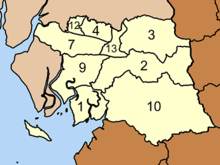
Tambon (Thai: ตำบล) or sub-districts are the third-level of administration. There are 7,255 tambon in Thailand. Tambon are responsible for the economic, societal, and cultural development of the area, organizing public services for the benefit of the people of their own locality.[23] In addition, under the 2001-2006 Thaksin Shinawatra government, the OTOP (One Tambon One Product) program was launched, aiming to promote and recognize unique traditions, cultures, and products from every tambon.[24]
History
Tambon were previously the second-level of administration before the establishment of amphoe. They were previously governed by a provincial capital who appointed a kamnan or phan as its leader. In 1892, they were downgraded into the third-level of administration.
Muban (villages)
Muban (Thai: หมู่บ้าน) or Villages are the fourth-level of administration in Thailand. There are 74,944 muban[25] in Thailand. A muban is led by a phuyaiban (Thai: ผู้ใหญ่บ้าน), who is chosen through local elections. All elected phuyaiban must be approved by the central government. Once in office, they can serve for a 5-year term with no limits on re-election. In cities, the term chumchon (Thai: ชุมชน) is used, although this is an unofficial title and is unrelated to the central government.
Local administrative divisions
Ordinary local administrative divisions
Thesaban (municipalities)
Thesaban (Thai: เทศบาล) or municipalities is the second level of administration. There are three types of municipalities: thesaban nakhon, thesaban muang, and thesaban tambon.
- Thesaban nakhon (เทศบาลนคร) is the highest of these municipalities and there are 30 of them. To qualify for a thesaban nakhon, an area needs to have at least 50,000 citizens and the necessary infrastructure for a city.
- Thesaban muang (เทศบาลเมือง) needs to have at least 10,000 citizens.
- Thesaban tambon (เทศบาลตำบล) is the lowest administrative level for a municipality. In order to qualify as a thesaban tambon, there needs to be an income of 5 million baht, 5,000 citizens, and a density of 1,500 per square km.
They are known for being complicated geographically. It can extend over a few tambons or be contained within a tambon. Their responsibility are to maintain public order, provide and maintain land and waterways, maintain cleanliness of roads. or corridors and public places Including the disposal of solid waste and sewage, and prevent and suppress contagious diseases.[26]
Originally thesaban were sanitation districts called sukhaphiban (Thai: สุขาภิบาล) created to manage waste. Sukhaphiban used to co-exist with thesaban until it was abolished in 1999.
Special local administrative divisions
There are two special administrative regions within Thailand: Bangkok and Pattaya. The SAR is an autonomous region governed separately from the central government. The mayor of the SARs is elected directly by the citizen of their respective SARs. The SAR category is an exclusive administration category where the central government had to have a bill passed exclusively to make a city a SAR. Note that the degree of autonomy is different between these two SARs. Bangkok is recognized as its own polity while Pattaya is under the administration of Chonburi province. Bangkok has its own khaet-khwang system and Pattaya uses the tambon-muban system. This makes Pattaya closer to a thesaban nakhon than a SAR, still, it is classified as a SAR.

Currently, there are plans to make Chiang Mai and Mae Sot a special local administrative area.[27] Though the plans for Chiang Mai is controversial due to the extreme centralization of the government. Especially within the parliament, conservatives called it separatism. A recent bill passed in 2005 and withdrawn in 2007 proposed a new province, Nakhon Suvarnabhumi, and was planned to be structured as a special local administrative area. As a result of a coup, the project was cancelled and withdrawn.
Khet and Khwang (special districts and sub-districts)

Only used in Bangkok, the khet-khwang system acts similarly to the amphoe-tambon system, with the Bangkok government (not to be confused with the central Thai government) appointing the directors of these districts. There are 50 khet and 180 khwang within Bangkok.
Informal administrative division
Krungthepmahanakhon lae Parimonthon (Bangkok Metropolitan Region)



Bangkok Metropolitan Region (Thai: กรุงเทพมหานครและปริมณฑล) refers to the surrounding provinces of Bangkok SAR. This division is used to refer to the whole Bangkok and its suburb. Since Bangkok has outgrown its own SAR borders, neighboring provinces’ city is being absorbed into the Bangkok metropolis, though retaining their respective local government. The polity is defined as Bangkok and the five surrounding provinces of Nakhon Pathom, Pathum Thani, Nonthaburi, Samut Prakan, and Samut Sakhon. This definition of Bangkok is commonly used in radio, news, and everyday life when people refer to Bangkok.[28]
Phak (region)
Phak (Thai: ภาค) refers to the grouping of multiple provinces with regard to history, culture, and geography. There are ten types of phak divisions: 6-regions, 5-4-regions, meteorological, tourism, economic, highway, landlines, postal, electoral, and scouts. In everyday life, one would expect to be using the 4-regions system due to its simplicity and wide understanding of this system.
The four regions system is composed of:
- North
- Isan
- Central
- South
The northern region closely resembles the former Kingdom of Lanna. This kingdom was split into five minor kingdoms in the 1800s and fully absorbed into Siam. Owing to their cultural differences, people from the central plains discriminate against the people of the frontiers regions of Siam. This ingrained the division between us and them within the Siamese psyche.
The Isan region resembles the old territory annexed from the Kingdom of Vientiane and Champassak. The southern region resembles the former territories of the Malay sultanates and the Kingdom of Nakhon Si Thammarat.[29]
Populations
| Regions[30] | Male | Female | Total | ||||||||
|---|---|---|---|---|---|---|---|---|---|---|---|
| Central | 10,984,989 | 11,857,239 | 22,842,228 | ||||||||
| Bangkok Metropolitan Area | 5,126,677 | 5,745,423 | 10,872,100 | ||||||||
| Bangkok Special Administrative Area | 2,592,292 | 2,935,702 | 5,527,994 | ||||||||
| Pattaya Special Administrative Area[31] | 47,773 | 50,598 | 98,372 | ||||||||
| North | 5,871,707 | 6,138,317 | 12,010,024 | ||||||||
| Isan | 10,814,540 | 11,012,380 | 21,826,920 | ||||||||
| South | 4,667,882 | 4,824,385 | 9,492,267 | ||||||||
| Total | 32,339,118 | 33,960,884 | 66,171,439 | ||||||||
Unorganized Administrative Region
During the reign of Rama III, there was a massive settlement effort, in which many city and town were created during this time. This caused a "great reshuffling" of the provinces' territory. This ended up leading to the creation of the unorganized region of Promthep. This region was the result of the breaking up of the Kingdom of Cambodia's northern region and annexing it as a part of Siam. Later, this region was partitioned and merged into the Kingdom of Champassak, Kingdom of Cambodia, Khukhan and Siemmarat.
Abolished administrative divisions
Monthon

Monthon (Thai: มณฑล) were administrative subdivisions of Thailand at the beginning of the 20th century. The Thai word monthon is a translation of the word mandala (maṇḍala, literally "circle"). The monthon were created as a part of the Thesaphiban[32] (เทศาภิบาล, literally "local government") bureaucratic administrative system, introduced by Prince Damrong Rajanubhab which, together with the monthon, established step-by-step today's present provinces (changwat), districts (amphoe), and communes (tambon) throughout Thailand. Each monthon was led by a royal commissioner called Thesaphiban (เทศาภิบาล), later renamed to Samuhathesaphiban (สมุหเทศาภิบาล). The system was officially adopted by the 1897 Local Administration Act.[10]
In 1915 there were 19 monthons containing 72 provinces. Due to economic problems, several monthon were merged in 1925. Monthon Phetchabun had been dissolved in 1915. Only 14 monthon remained: Ayutthaya, Bangkok (Krung Thep), Chanthaburi, Nakhon Chaisi, Nakhon Ratchasima, Nakhon Sawan, Nakhon Si Thammarat, Pattani, Phayap, Phitsanulok, Phuket, Prachinburi, Ratchaburi, and Udon Thani. In 1932 another four were abolished: Chanthaburi, Nakhon Chaisi, Nakhon Sawan, and Pattani. Finally in 1933 the whole monthon system was abolished by the Provincial Administration Act 2476 B.E./A.D. 1933, part of the changes made after the coup d'état, which changed from an absolute to a constitutional monarchy.
| Monthon | มณฑล | Established | Fate |
|---|---|---|---|
| Lao Klang | ลาวกลาง | 1890 | 1893 - renamed Monthon Nakhon Ratchasima |
| Lao Tawan Ok | ลาวตะวันออก | 1890 | 1891 - merged with Monthon Lao Tawan Ok Chiang Nua becoming Monthon Lao Kao |
| Lao Tawan Ok Chiang Nua | ลาวตะวันออกเฉียงเหนือ | 1890 | 1891 - merged with Monthon Lao Tawan Ok becoming Monthon Lao Kao |
| Lao Phuan | ลาวพวน | 1890 | 1893 - renamed Monthon Udon after ceding the west bank of the Mekong. |
| Lao Kao | ลาวกาว | 1891 | 1893 - renamed Monthon Isan |
| Lao Phung Khao | ลาวพุงขาว | 1893 | 1893 - abolished, due to the annexation of territory to French Third Republic |
| Lao Chiang | ลาวเฉียง | 1893 | 1900 - renamed into Monthon Tawan Ok Chiang Neua |
| Krung Kao | กรุงเก่า | 1893 | 1933 - abolished, abolishment of the monthon system |
| Prachinburi | ปราจิณบุรี | 1893 | 1933 - abolished, abolishment of the monthon system |
| Khamen | เขมร | 1893 | 1899 - renamed Monthon Burapha |
| Nakhon Ratchasima | นครราชสีมา | 1893 | 1933 - abolished, abolishment of the monthon system |
| Isan | อีสาน | 1893 | 1912 - partitioned into Monthon Roi Et and Monthon Ubon |
| Phitsanulok | พิษณุโลก | 1894 | 1933 - abolished, abolishment of the monthon system |
| Nakhon Sawan | นครสวรรค์ | 1895 | 1932 - merged into Monthon Krung Kao - Ayutthaya |
| Ratchaburi | ราชบุรี | 1895 | 1933 - abolished, abolishment of the monthon system |
| Nakhon Chai Si | นครไชยศรี | 1895 | 1932 - merged into Monthon Ratchaburi |
| Chumphon | ชุมพร | 1896 | 1925 - merged into Monthon Nakhon Si Thammarat |
| Nakhon Si Thammarat | นครศรีธรรมราช | 1896 | 1933 - abolished, abolishment of the monthon system |
| Syburi | ไทรบุรี | 1897 | 1909 - abolished, due to the annexation of territory to British Empire |
| Krung Thep | กรุงเทพ | 1897 | 1922 - merged into Monthon Krung Kao - Ayutthaya |
| Phuket | ภูเก็จ | 1898 | 1933 - abolished, abolishment of the monthon system |
| Phetchabun | เพชรบูรณ์ | 1899
1907 |
1903 - merged into Monthon Phitsanulok
1916 - merged into Monthon Phitsanulok |
| Burapha | บูรพา | 1899 | 1906 - abolished, due to the annexation of territory to French Third Republic |
| Tawan Ok Chiang Neua | ตะวันตกเฉียงเหนือ | 1900 | 1901 - renamed into Monthon Phayap |
| Phayap | พายัพ | 1901 | 1933 - abolished, abolishment of the monthon system |
| Udon | อุดร | 1901 | 1933 - abolished, abolishment of the monthon system |
| Pattani | ปัตตานี | 1906 | 1932 - merged into Monthon Nakhon Si Thammarat |
| Chanthaburi | จันทบุรี | 1906 | 1933 - merged into Prachinburi |
| Roi Et | ร้อยเอ็จ | 1912 | 1932 - merged into Nakhon Ratchasima |
| Ubon | อุบล | 1912 | 1932 - merged into Nakhon Ratchasima |
| Maharat | มหาราษฎร์ | 1915 | 1926 - merged into Monthon Phayap |

- Monthon Lao Chiang is the same as Monthon Phayap, to ease understanding in this table but in all cases, they are the same.
- Monthon Lao Kao which became Monthon Isan, and Monthon Lao Phuan which became Monthon Udon.
- The use of the name is up to interpretation and use on case-by-case basis, but name changes occurs due to Rama V integration policy of minorities and achieving assimilation.
- Province merger not shown, only monthon partition and merger are
Boriwen
Boriwen (Thai: บริเวณ) was created due to the size of the three largest monthon hence a subdivision of monthons. Several provinces were grouped together into one boriwen. In 1908 the boriwen were renamed to changwat, which became the name of provinces in 1916. The monthon with between three and five boriwen were Phayap, Udon Thani and Isan. Each boriwen was administered by a commissioner (khaluang boriwen, ข้าหลวงบริเวณ).
Sukhaphiban
Sukhaphiban (Thai: สุขาภิบาล) were administrative divisions of Thailand. Sukhaphiban were the first sub-autonomous entities established in Thailand. A first such district was created in Bangkok by a royal decree of King Chulalongkorn in 1897. Tha Chalom District became the second such district, created in 1906 and responsible for parts of Mueang Samut Sakhon District, Samut Sakhon Province.
In 1907 the act on operations of sanitary districts codified the regulations, and with the Local Administration Act of 1914 two levels of sukhaphiban were introduced, the sukhaphiban mueang for towns and sukhaphiban tambon for rural areas.
The number of sanitary districts grew to 35 in 1935, when these however were converted into municipalities (thesaban). New sanitary district were again established starting in 1952 by prime minister Phibun Songkhram. With the Act to Upgrade Sanitary Districts to Thesaban of May 1999 they were again abolished, and all became thesaban tambon.[33]
Muang Prathetsarat

Vassal states (Thai: เมืองประเทศราช) existed within Thailand for centuries since the founding of Sukhothai. Though not directly part of the country or even arguably an administrative division. Nonetheless, these states deserve a mention which is due to the fact that they are an entity within a certain polity.
Describing past vassals of Thailand requires the understanding of the mandala system. The mandala system is a largely diffused and dispersed power structure. This means that a vassal is largely independent to the central state, with the vassal also retaining sub-servient city-state-vassals. To explain this power structure, imagine if the United States is the central state, and Washington DC is the central state with 50 surrounding vassal states giving tributes to the central state and having open borders within these polities. These state-vassals also have subservient counties with autonomy in their internal affairs with these counties having their own autonomous sub-divisions. Thus, creating a pyramid of subservient cities and polities. It is not the current political structure of the United States due to the fact that the individual states could not just declare independence, which these vassal could, and had more autonomy from the central state. If the vassal states were to declare independence, it would incur the wrath of the central state. In history this was seen even when the Kingdom of Vientiane, a vassal, rebelled and lost which then was dissolved and absorbed into the central state.
The relationships between Thailand and its vassal varies over the centuries. It could be as amicable and the relationship that of the Kingdom of Nakhon Si Thammarat. Compared with the less amicable, aforementioned, Kingdom of Vientiane, which started a rebellion in 1826 under King Anouvong (Xaiya Setthathirath V). The last vassal state to be subservient to Thailand was the Malay states, which was subsequently dissolved, ceded, and merged into provinces and British Malaya in 1909, and the Kingdom of Champassak, which was downgraded into a province.[13][14][15][16][17][18][19]
Far Northern Frontier
Northern Frontier
| Vassal States and Dependencies | Thai Name | Period Under Suzerainty | Today Part of | Fate |
|---|---|---|---|---|
| Anachak Sukhothai
Kingdom of Sukhothai |
อาณาจักรสุโขทัย
Anachak Sukhothai |
1378–1438 |
| |
| Meuang Thoen
Principality of Thoen |
เมืองเถิน
Meuang Thoen |
1776-1915 |
| |
| Rattana Tingsa Aphinawapuri Si Khuru Rattha Phra Nakhon
Kingdom of Chiang Mai |
นครเชียงใหม่
Nakhon Chiang Mai |
1775–1939 |
| |
| Nakhon Meuang Lampang
Principality of Lampang |
นครเมืองลำปาง
Nakhon Meuang Lampang |
1775–1922 |
| |
| Nakhon Muang Nan
Principality of Nan |
นครเมืองน่าน
Nakhon Meuang Nan |
1775–1931 |
| |
| Nakhon Lamphun
Principality of Lamphun |
นครลำพูน
Nakhon Lamphun |
1775–1926 |
| |
| Meuang Phrae
Principality of Phrae |
เมืองแพร่
Meuang Phrae |
1775–1902 |
|
Southern Frontier
| Vassal States and Dependencies | Thai Name | Period Under Suzerainty | Today Part of | Fate | |
|---|---|---|---|---|---|
| Kingdom of Ligor
Kingdom of Nakhon Si Thammarat |
อาณาจักรนครศรีธรรมราช
Anachak Nakhon Si Thammarat |
1st | 1238–1767 |
| |
| 2nd | 1769–1784 | ||||
| Kesultanan Kedah
Sultanate of Kedah |
อาณาจักรเกอดะฮ์
Anachak Koeda |
1821–1909 |
| ||
| Kerajaan Setul Mambang Segara
Kingdom of Setul Mambang Segara |
ราชอาณาจักรเซอตุล
Racha Anachak Seotun |
1808–1909 |
| ||
| Perlis Indera Kayangan
Kingdom of Perlis |
อาณาจักรปะลิส
Anachak Palit |
1843–1909 |
| ||
| Kerajaan Kubang Pasu Darul Qiyam
Kingdom of Kubang Pasu Darul Qiyam |
อาณาจักรกุปังปาสู
Anachak Kubang Pasu |
1839–1864 |
| ||
| Kesultanan Pattani
Sultanate of Patani |
อาณาจักรปัตตานี
Anachak Pattani |
1786–1902 |
| ||
| Kerajaan Reman
Kingdom of Rahman |
อาณาจักรรามัน
Anachak Raman |
1902-1909 |
| ||
| Kesultanan Terengganu
Sultanate of Terengganu |
อาณาจักรตรังกานู
Anachak Trangkanu |
1786–1909 |
| ||
| Kerajaan Besut Darul Iman
Kingdom of Besut Darul Iman |
อาณาจักเบอซุต
Anachak Boesut |
1780–1899 |
| ||
| Kesultanan Kelantan
Sultanate of Kelantan |
อาณาจักรกลันตัน
Anachak Klantan |
1786–1909 |
| ||
Eastern Frontier
| Vassal States and Dependencies | Thai Name | Period Under Suzerainty | Today Part of | Fate | |
|---|---|---|---|---|---|
| Krong Kampoucheathibtei
Kingdom of Cambodia |
อาณาจักรกัมพูชา
Anachak Kampucha |
1st | 1594–1831 |
| |
| 2nd | 1845–1863 | ||||
| Principality of Hà Tiên
Ha Tien Protectorate |
เมืองพุทไธมาศ
Meuang Phutthaimat |
1785–1809 |
| ||
| Muang Si Phum
Principality of Si Phum |
เมืองศรีภูมิ
Muang Si Phum |
1768–1772 |
| ||
| Anachak Champassak
Kingdom of Champasak |
อาณาจักรจำปาศักดิ์
Anachak Champasak |
1779–1904 |
| ||
| Muang Don Mot Daeng
Principality of Don Mot Daeng |
เมืองดอนมดแดง
Muang Don Mot Daeng |
1777-1778 |
| ||
| Anachak Viengchan
Kingdom of Vientiane |
อาณาจักรเวียงจันทน์
Anachak Viengchan |
1779–1828 |
| ||
| Muang Phuan
Principality of Phuan |
เมืองพวน
Muang Phuan |
1779–1888 |
| ||
| Houa Phanh Than Ha Thang Hoc
Federation of the Six Hua Phan Cantons |
หัวพันทั้งห้าทั้งหก
Hua Phan Thang Ha Thang Hok |
1779–1888 |
| ||
| Anachak Luang Phrabang
Kingdom of Luang Prabang |
อาณาจักรหลวงพระบาง
Anachak Luang Phrabang |
1779–1893 |
| ||
| Muang Phongsali
Principality of Phongsali |
เมืองพงสาลี
Muang Phongsali |
1779–1893 |
| ||
| Sip Song Chau Tai
Federation of the 12 Tai Cantons*
|
สิบสองจุไทย
Sipsong Ju Thai |
1st | 1779–1806 |
| |
| 2nd | 1835–1888 | ||||
Western Frontier
| Vassal States and Dependencies | Thai Name | Period Under Suzerainty | Today Part of | Fate | |
|---|---|---|---|---|---|
| Kingdom of Hongsarwatoi
Kingdom of Hanthawaddy |
อาณาจักรหงสาวดี
Arnajak Hongsawadi |
1st | 1287–1298 |
| |
| 2nd | 1307–1317 | ||||
| 3rd | 1330 | ||||
*Twelve Cantons were actually composed of twelve to sixteen different cantons. Note that throughout the centuries, different cantons held the same seats. The number of seats range from 12 to 16.
**Chiang Khaeng was merged with the Principality of Nan after the transfer.
Lost Territories
There are various territories which were partitioned and transferred to another political entity over the centuries. This could be either that the central government gave an order, or an independent action acted upon by the individual muang prathetsarat.
| Map | Territory | เขตการปกครอง | Period Under Suzerainty | Fate | Today part of |
|---|---|---|---|---|---|
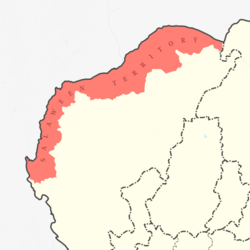 |
Salaween Territory | ดินแดนสาละวิน | 1802–1892 | Traded to Karenni State and Shan State, British Burma,
gaining Chiang Khaeng. |
|

|
Chiang Khaeng Territory | ดินแดนเมืองเชียงแขง | 1892–1893 | Transferred to the French Third Republic | |

|
Koh Song Territory | ดินแดนเกาะสอง | 1769–1864 | Ceded to the British Empire | |

|
Miawdi Territory | ดินแดนเมียวดี | 1768–1834 | Gifted to the British Empire, from the Kingdom of Chiang Mai | |

|
Mohtahmah Territory | ดินแดนเมาะตะมะ | 1287–1548
1594–1613 1662 |
Ceded to the Toungoo Dynasty, regained
Ceded to the Toungoo Dynasty, regained Ceded to the Konbaung Dynasty (Third Burmese Empire) |
|

|
Thawai Territory | ดินแดนทวาย | 1287–1548
1593–1613 1662 |
Ceded to the Toungoo Dynasty, regained
Ceded to the Toungoo Dynasty, regained Ceded to the Konbaung Dynasty (Third Burmese Empire) |
|
 |
Tanaosi Territory | ดินแดนตะนาวสี | 1287–1564
1593–1614 1756–1760 |
Ceded to the Toungoo Dynasty, regained
Ceded to the Toungoo Dynasty, regained Ceded to the Konbaung Dynasty (Third Burmese Empire) |
Former administrative division maps
- Sukhothai administrative division in 1293 (Ramkhamhaeng)
- Ayutthaya administrative division in 1767 (Borommaracha III)
- Thonburi administrative division in 1780 (Borommaracha IV)
- Rattanakosin administrative division in 1800 (Rama I)
- Rattanakosin administrative division in 1805 (Rama I)
- Rattanakosin administrative division in 1824 (Rama II)
- Rattanakosin administrative division in 1837 (Rama III)
- Rattanakosin administrative division in 1850 (Rama III)
- Rattanakosin administrative division in 1882 (Rama V)
- Siamese administrative division in 1890 (Rama V)
- Siamese administrative division in 1893 (Rama V)
- Siamese administrative division in 1900 (Rama V)
- Siamese monthon division in 1900 (Rama V)
- Siamese administrative division in 1906 (Rama V)
- Siamese administrative division in 1916 (Rama VI)
- Siamese administrative division in 1932 (Rama VII)
- Thai administrative division in 1941 (Rama VIII)
- Thai administrative division in 1945 (Rama VIII)
- Thai administrative division in 1950 (Rama IX)
- Thai administrative division in 1973 (Rama IX)
- Thai administrative division in 2023 (Rama X)
References
- ^ Paik, Christopher; Vechbanyongratana, Jessica (12 April 2019). "Path to Centralization and Development: Evidence from Siam". World Politics. 71 (2): 289–331. doi:10.1017/S0043887118000321. ISSN 0043-8871. S2CID 159375909.
- ^ "Regions Map of Thailand – Nations Online Project". www.nationsonline.org. Retrieved 2023-01-07.
- ^ "สรุปข้อมูล อปท ทั่วประเทศ". www.dla.go.th. Retrieved 2023-01-07.
- ^ "Thailand – Chulalongkorn's Reforms". countrystudies.us. Retrieved 2023-01-07.
- ^ "หมวด ๑ จังหวัด (มาตรา ๕๒ – ๖๐) | สถาบันนิติธรรมาลัย". www.drthawip.com. Retrieved 2023-01-07.
- ^ "Mandala". Indianisation in SEA. Retrieved 2023-11-14.
- ^ "คำศัพท์ ขุนหลวง แปลว่าอะไร?". Longdo Dict. Retrieved 2023-11-14.
- ^ "ระเบียบการปกครองสมัยอยุธยา". www.nectec.or.th. Retrieved 2023-01-07.
- ^ "Franco-Siamese War 1893". onwar.com. Retrieved 2023-11-14.
- ^ a b Bunnag, Tej; Rajanubhab, Damrong; Damrong Rajanubhab (1977). The provincial administration of Siam, 1892-1915: the Ministry of the Interior under Prince Damrong Rajanubhab. East Asian Historical Monographs. Kuala Lumpur London: Oxford Univ. Pr. ISBN 978-0-19-580343-3.
- ^ Thailand, the Government of. Act Establishing Bueng Kan Province, BE 2554 (2011).
- ^ "Bangkok District Offices". 2011-05-10. Archived from the original on 2011-05-10. Retrieved 2023-11-14.
- ^ a b c Worobec, C. D. (2001-09-01). "Land Reform in Russia 1906-1917: Peasant Responses to Stolypin's Project of Rural Transformation". Journal of Social History. 35 (1). By Judith Pallot (New York: Oxford University Press, 1999. viii plus 255pp.): 238–240. doi:10.1353/jsh.2001.0107. ISSN 0022-4529. S2CID 142697874.
- ^ a b "The dynastic chronicles, Bangkok era, the first reign / Chaophraya Thiphakorawong edition; translated... - Catalogue | National Library of Australia". nla.gov.au. Retrieved 2023-11-14.
- ^ a b Andaya, Barbara Watson; Andaya, Leonard Y. (1982). A History of Malaysia. St. Martin's Press. ISBN 978-0-312-38120-2.
- ^ a b "Pentadbiran : Pusat- pusat Pentadbiran Kedah Darul Aman Dari Bukit Meriam Ke Kota Setar [2]". 2017-09-04. Archived from the original on 2017-09-04. Retrieved 2023-11-14.
- ^ a b Porath, Nathan (2011). "The <i>Hikayat Patani</i>: The Kingdom of Patani in the Malay and Thai Political World". Journal of the Malaysian Branch of the Royal Asiatic Society. 84 (2): 45–65. doi:10.1353/ras.2011.0016. ISSN 2180-4338. S2CID 154427967.
- ^ a b dai ke lai (1991). ling nan zhi guai deng shi liao san zhong. zheng zhou. ISBN 978-7-5348-0203-4.
{{cite book}}: CS1 maint: location missing publisher (link) - ^ a b Wyatt, David K. (2009). "Siam and Laos, 1767–1827". Journal of Southeast Asian History. 4 (2): 19–47. doi:10.1017/S0217781100002787. ISSN 0217-7811.
- ^ "Supplemental Information 2: Ministry of Interior Taiwan, Statistics: annual report of the Ministry of the Interior". doi:10.7717/peerj.13117/supp-2.
{{cite web}}: Missing or empty|url=(help) - ^ "บทบาทหน้าที่ของที่ทำการปกครองอำเภอ". www.oic.go.th. Retrieved 2023-01-07.[permanent dead link]
- ^ Bass (30 December 2021). ""อำเภอ" มาจากไหน? ยุคแรกจัดตั้งอำเภออย่างไร กรมการอำเภอทำหน้าที่อะไร". ศิลปวัฒนธรรม (in Thai). Retrieved 2023-01-07.
- ^ "บทบาทหน้าที่ องค์การบริหารส่วนตำบลปากรอ". www.parkrore.go.th. Retrieved 2023-01-07.
- ^ "What is OTOP?". Royal Thai Embassy Singapore.
- ^ "Original PDF". doi:10.15438/rr.5.1.7 (inactive 1 November 2024).
{{cite journal}}: Cite journal requires|journal=(help)CS1 maint: DOI inactive as of November 2024 (link) - ^ "อำนาจหน้าที่ เทศบาล". www.isan.go.th. Retrieved 2023-01-07.
- ^ "The Office of Public Relations Advisor to the Prime Minister". Parliamentary Affairs. 1955. doi:10.1093/oxfordjournals.pa.a052896. ISSN 1460-2482.
- ^ Mammedov, Dadaş (2021-08-14). "กรุงเทพมหานครและปริมณฑล". www.wiki3.th-th.nina.az (in Thai). Retrieved 2023-11-14.
- ^ "แผนที่ประเทศไทย 77 จังหวัด ชัดๆ โดยละเอียด แบ่งภาค 6 ภาค อะไรบ้าง". www.thairath.co.th (in Thai). 2023-06-13. Retrieved 2023-11-14.
- ^ "สถิติประชากรศาสตร์ ประชากรและเคหะ". statbbi.nso.go.th. Archived from the original on 2022-04-20. Retrieved 2023-03-03.
- ^ th.zhujiworld.com. "พัทยา, ไทย — สถิติ 2023". th.zhujiworld.com (in Thai). Retrieved 2023-03-03.
- ^ "คำศัพท์ มณฑล แปลว่าอะไร?". Longdo Dict. Retrieved 2023-11-14.
- ^ https://web.archive.org/web/20080409014432/http://www.ratchakitcha.soc.go.th/DATA/PDF/2542/A/009/1.PDF. Archived from the original (PDF) on 2008-04-09. Retrieved 2023-11-14.
{{cite web}}: Missing or empty|title=(help)

